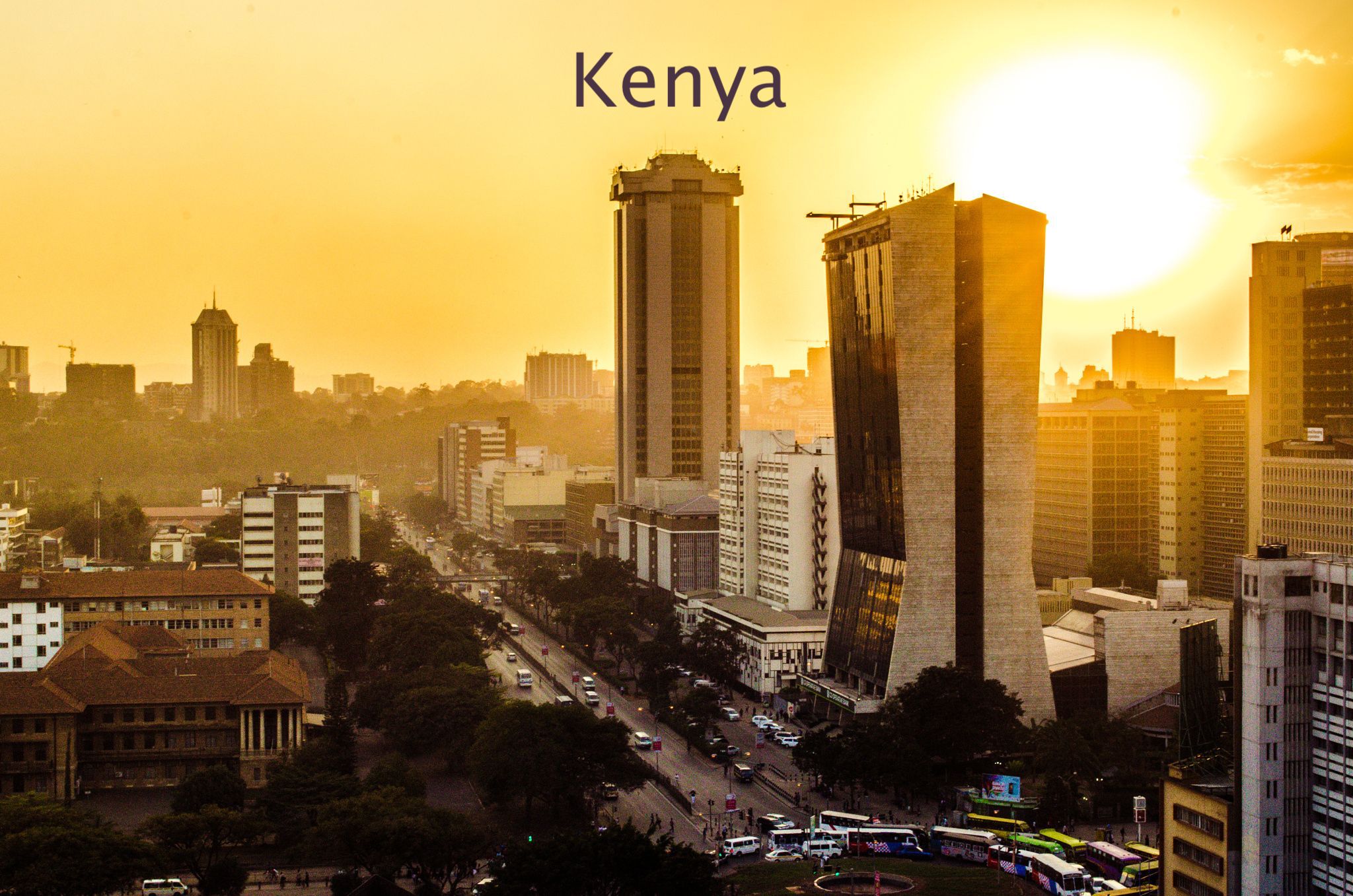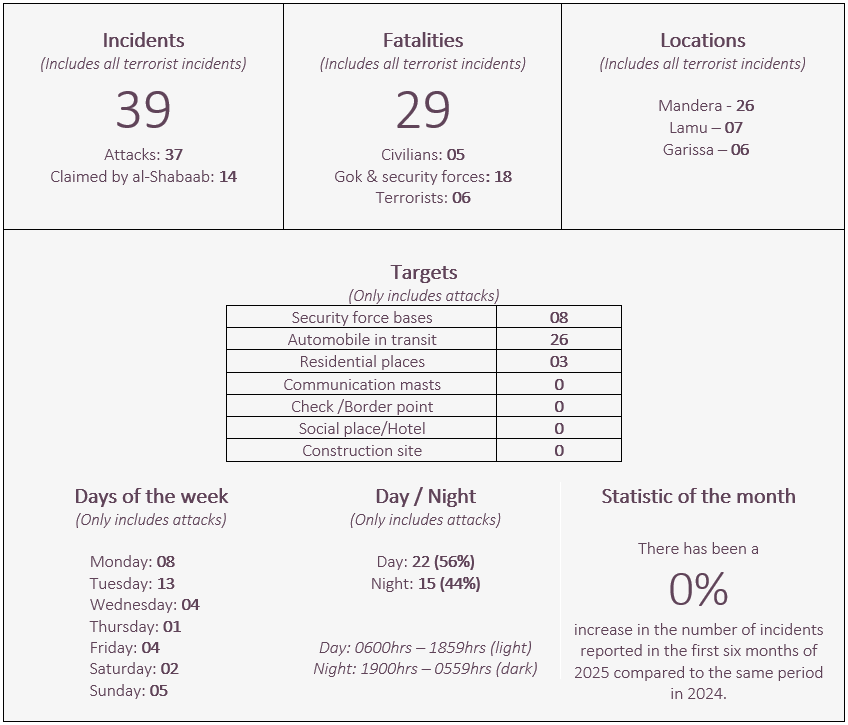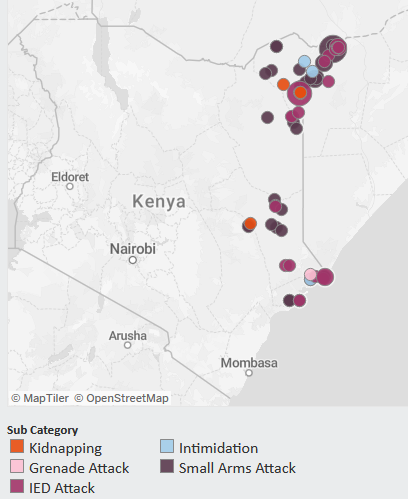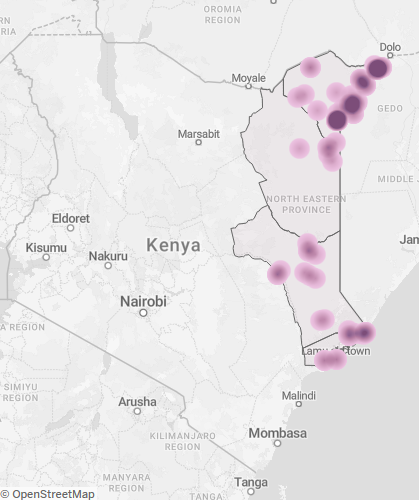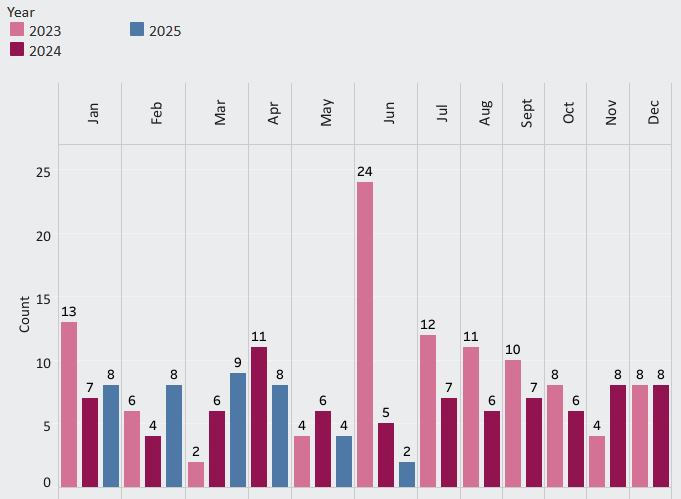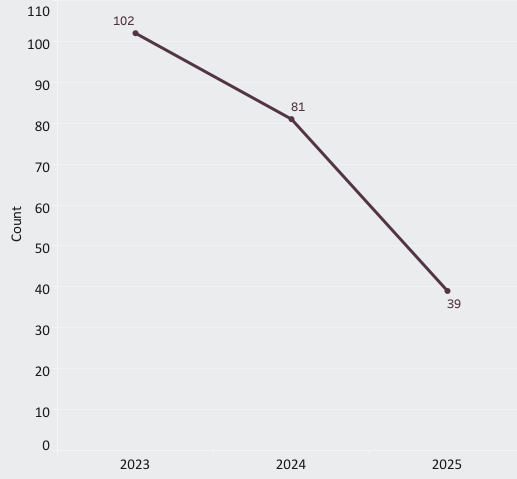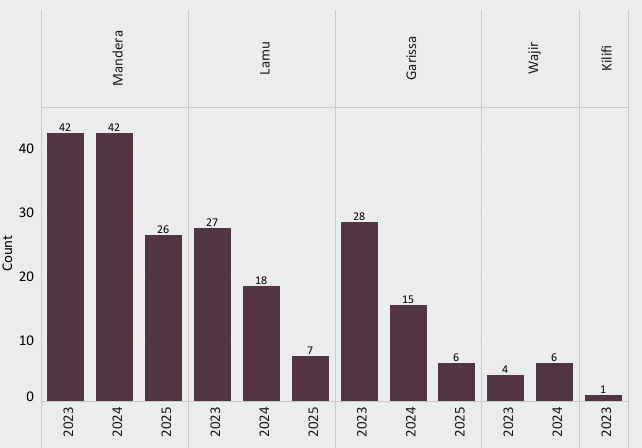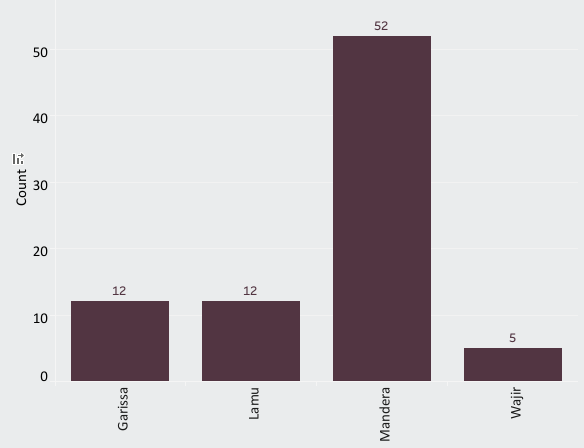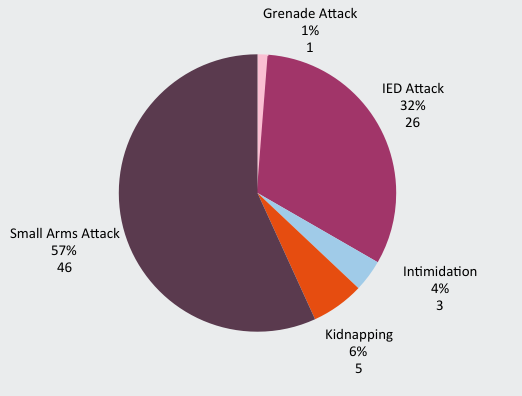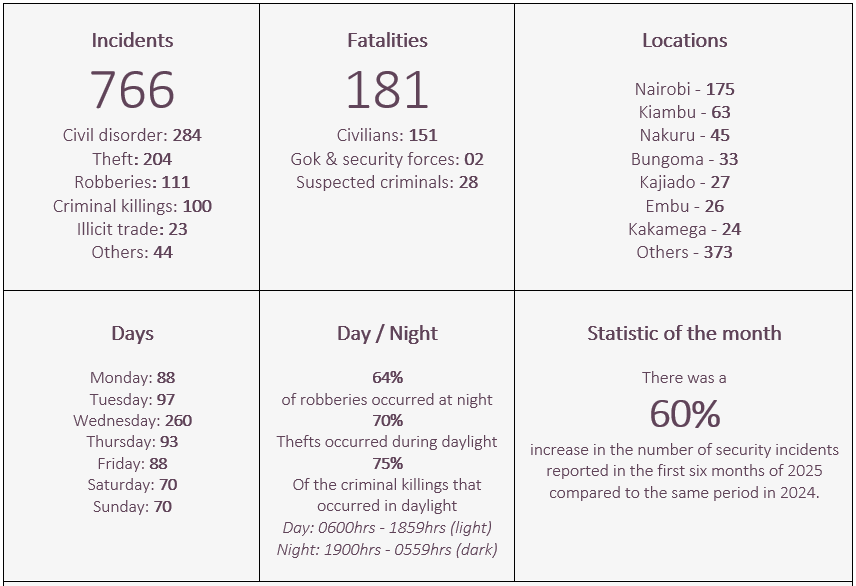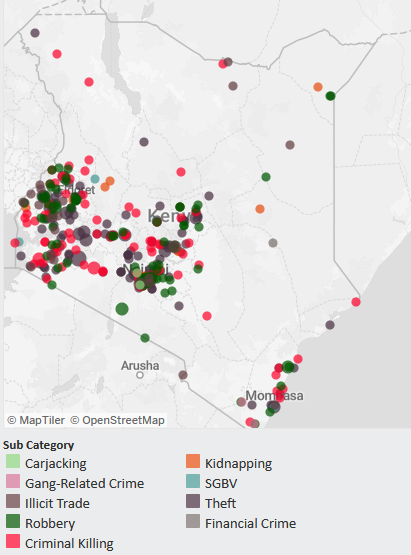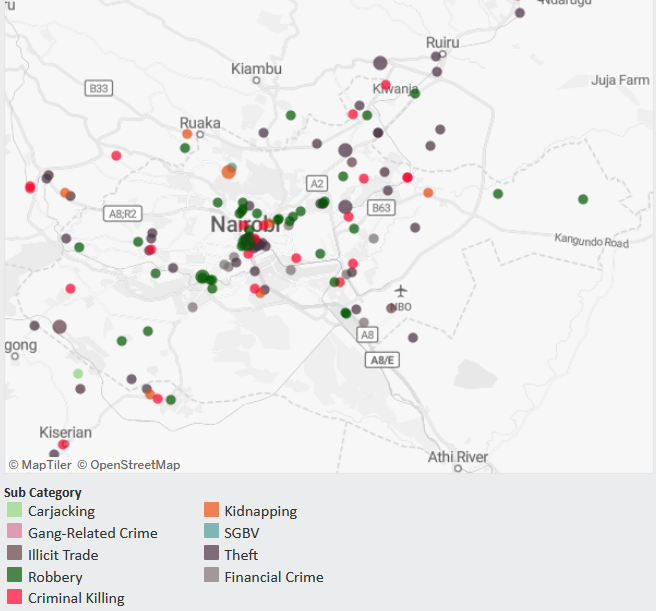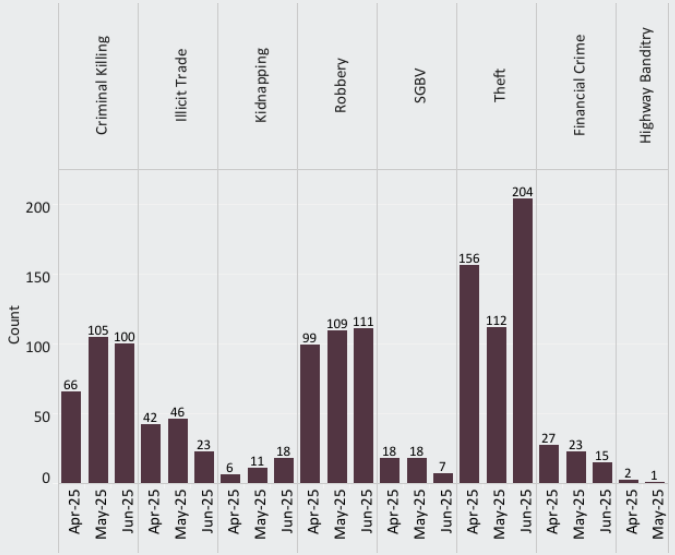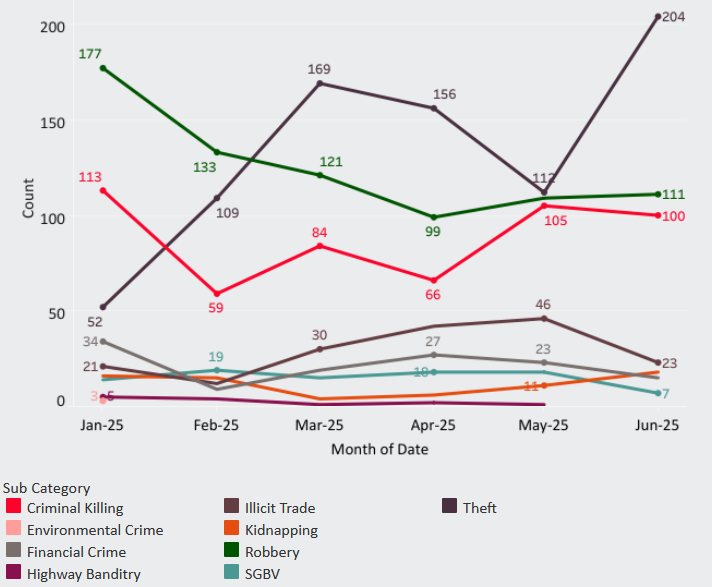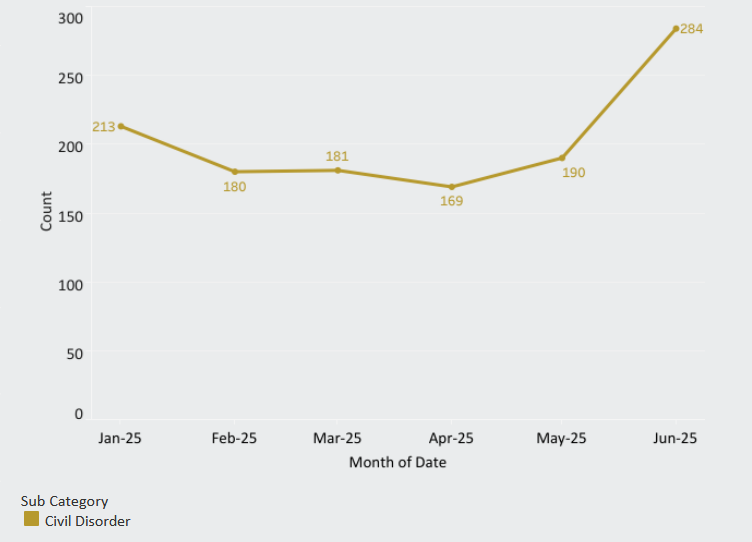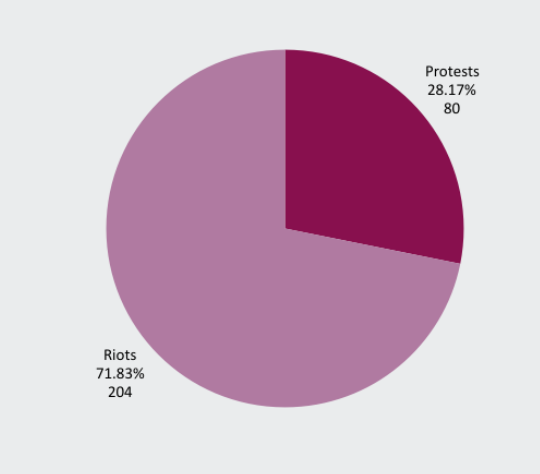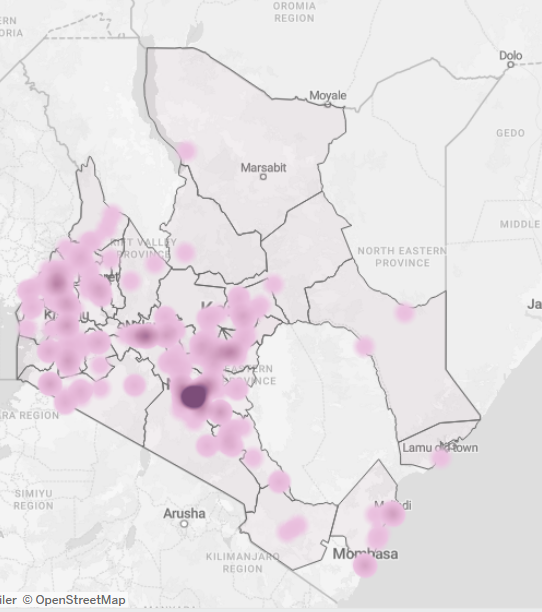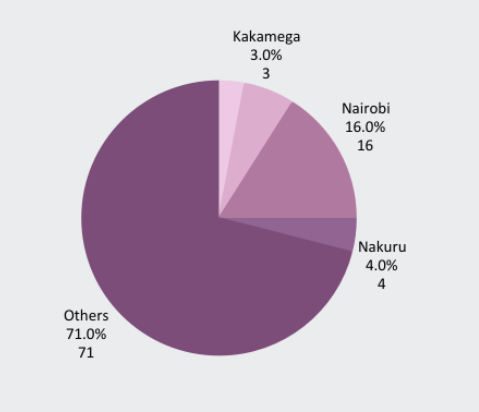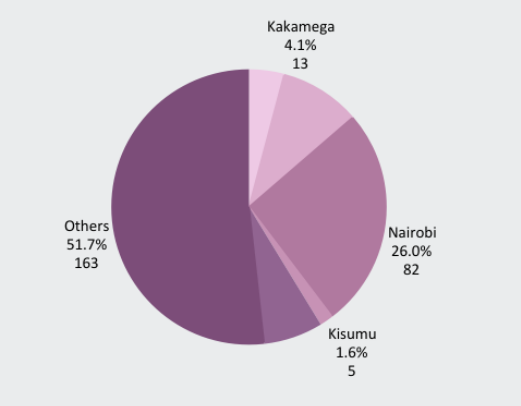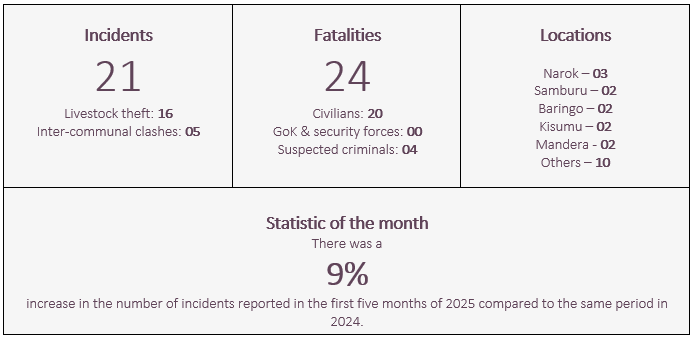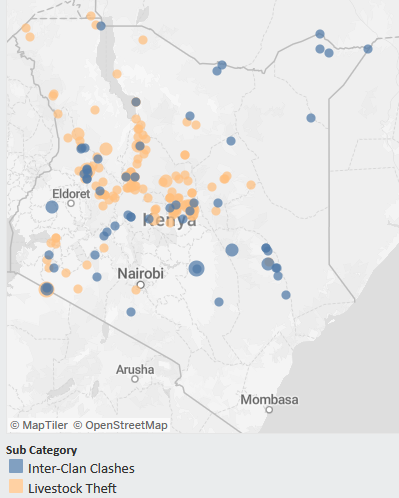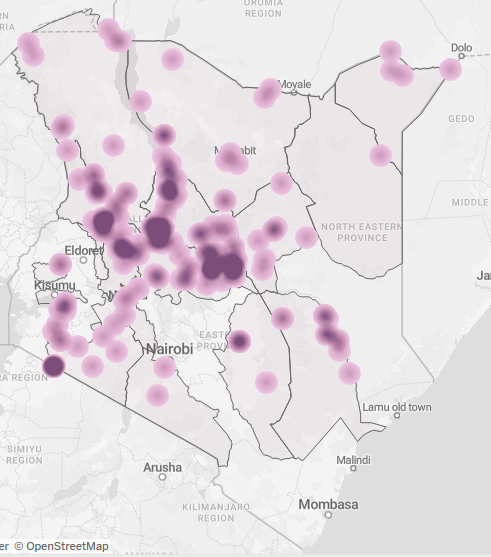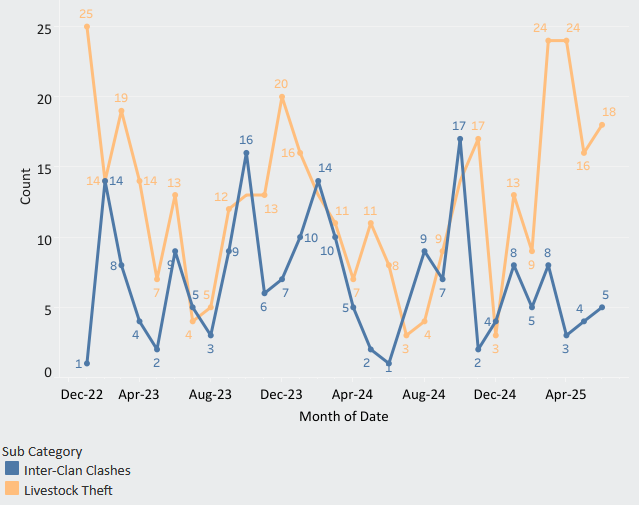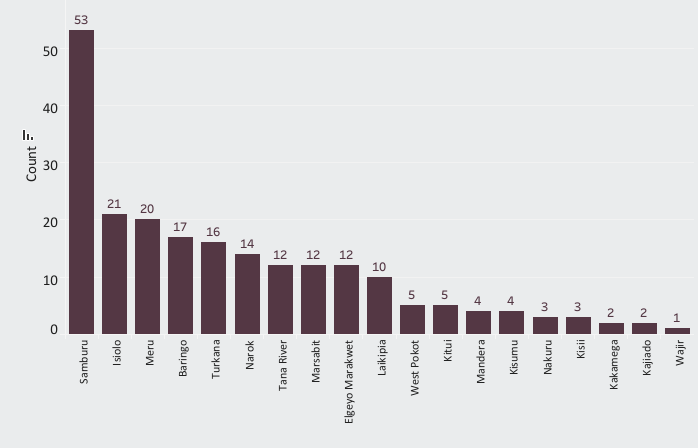Monthly Security Report
Issued on Thursday 03 July 2025
|
Sunday 01 June to Monday 30 June 2025
|
Dear Client, Please find below our most recent Kenya Monthly Security Report. If you have any queries about our reports please contact us at africaops@castorvali.com. |
Terrorism incidents - The last 12 months |
Terrorism heat map - The last 12 months |
1. Garissa County – Tuesday 03 June On Tuesday 03 June, a military truck was struck by an improvised explosive device (IED) in the Wel Marer area of Ijara sub-county. The attack, claimed by al-Shabaab, allegedly caused an unspecified number of casualties. 2. Mandera County – Wednesday 18 June Around 1300hrs on Wednesday 18 June, four suspected al-Shabaab militants ambushed a lorry in Shimbir Fatuma, Mandera Central sub-county. Two non-local workers were abducted, while the remaining four local workers escaped unharmed. Al-Shabaab claimed responsibility for the incident. |
Numbers of terrorism incidents in Kenya by month - 2023 to 2025 |
Two terrorism-related incidents were reported during the review period, occurring in Mandera and Garissa counties. These included the abduction of two non-locals and an IED attack targeting a military vehicle. Al-Shabaab claimed responsibility for both incidents, underscoring their continued presence in Kenya’s northeastern region despite the relatively low number of attacks recorded in June. Since the beginning of the year, Castor Vali has recorded 39 terrorism incidents across the country, all occurring in three of the four counties bordering Somalia. March has so far recorded the highest number of incidents with nine, followed by January, February, and April with eight each. May and June remained comparatively quiet, with four and two incidents reported, respectively. This trend mirrors that of June 2024, when five incidents were recorded, and marks a substantial decrease compared to June 2023, which saw 24 attacks. Overall, there has been no year-on-year change in the total number of attacks for the first half of 2025 and 2024, with 39 incidents reported in each period. Notable counterterrorism operations Despite the decline in attacks during the reporting period, security agencies have maintained proactive counterterrorism measures, likely disrupting planned operations. Key actions included: - Garissa: On Monday 02 June, Kenya’s Special Operations Group (SOG) conducted a successful operation in the Najo and Guracho areas, killing four al-Shabaab militants. Triggered by aerial surveillance, the operation led to a ground confrontation in which officers recovered a cache of weapons, including several AK-47 rifles, a PKM machine gun, and communication equipment.
- Mandera: On Tuesday 10 June, two al-Shabaab militants were reportedly killed by SOG officers while attempting to plant an IED along the Alungu–Elwak Road.
- Nairobi: On Tuesday 17 June, officers from Kamukunji Police Station apprehended a suspect displaying suspicious behaviour. A search of his belongings revealed 21 detonators, 21 packets of suspected ammonium nitrate, a five-metre electric cable, and other suspicious items. Although no direct links to a terrorist organisation have been confirmed, the incident highlights ongoing vigilance and proactive efforts by security forces, particularly in high-risk areas.
- Mandera: On Sunday 29 June, police officers reportedly killed several al-Shabaab militants following a gunfight in Guba, Banisa Constituency.
Elite units, including the SOG and other police and military formations, remain active along the Kenya–Somalia border, maintaining contact with militants and cooperating with other security agencies and local communities to gather and act on intelligence. These ongoing operations are assessed to have disrupted several planned attacks. Recovered items indicate al-Shabaab continues to favour IEDs and small arms in its operations. Although the number of reported attacks declined in June, al-Shabaab’s operational presence and capabilities in the northeastern region remain intact. The group continues to exploit cross-border infiltration routes, particularly via Mandera and Garissa counties. Seizures of combat-grade weaponry and explosives point to the militants’ sustained intent to conduct assaults, especially along main supply routes. Non-local civilians, healthcare workers, and security personnel remain prime targets. Al-Shabaab’s tactics, ranging from small arms attacks and IEDs to abductions, remain consistent. Moreover, regional instability linked to tensions in the Middle East involving Israel, the United States, and Iran may embolden extremist groups such as al-Qaeda, potentially leading to calls for attacks against Western or Israeli interests, further complicating the regional security landscape. |
The cumulative terrorism attack trend in Kenya - 2022 to date |
Terrorism statistics by county - January 2023 to date |
Comparison of terrorism incidents in June 2024 vs June 2025 |
Terrorism incidents in Kenya by county – The last 12 months |
Terrorism incidents in Kenya by mode of attack – The last 12 months |
Robbery and theft targets |
See here for our definitions of criminal incidents. |
Crime mapping Kenya map - June |
Kenya crime heat map - June |
Crime incidents by month, covering the last three months |
Crime incidents by month, covering January 2025 to date |
The review period recorded a 24% increase in overall criminal incidents and civil disorder compared to May, largely driven by a rise in civil unrest and thefts. Several key trends were observed: - A rise in robberies and thefts: Robbery and theft incidents rose by 43% compared to May. More than two-thirds (64%) involved break-ins targeting commercial and residential properties. Some criminals exploited the disorder during the 12, 17, and 25 June unrest to break into businesses in key towns affected by the demonstrations.
- Targeting of bank clients: The trend of criminals impersonating traffic police officers and targeting individuals shortly after they withdraw large sums of cash from banks persisted into the second consecutive review period. This pattern was extensively covered in the May report, in which Castor Vali recorded three such incidents.
Rise in residential break-ins in Nairobi's affluent suburbs: There has been a rise in break-ins targeting affluent residential areas in Nairobi. Criminal gangs, often posing as utility workers, have stolen electronics, jewellery and other valuables, escaping in getaway vehicles. The incidents occurred in gated communities, raising suspicions of possible inside involvement by domestic workers or private security staff. - Surge in civil unrest: The review period was marked by a notable increase in incidents of civil unrest, primarily linked to the nationwide demonstrations leading up to, and including, the first anniversary of the 25 June anti-finance bill protests. Indeed, there was a 50% rise in the number of unrest-related events during this period compared to May.
- Identified crime hotspots: The counties of Nairobi, Kiambu, Bungoma, Kajiado, and Nakuru emerged as the most affected, collectively accounting for 51% of all reported incidents. Nairobi remained the primary hotspot, alone representing 23% of the total reported cases.
- Gang related crime in Nakuru: In Nakuru town and its surrounding areas, the threat of gang-related crime remained high, resulting in the fatal shooting of a police officer on patrol in the Free Area of Nakuru town by suspected gang members. Two other officers sustained injuries during the attack.
- Outlook: The risk of unrest in the short to medium term remains elevated. Another wave of demonstrations is likely to coincide with the Saba Saba (07 July) anniversary, a date of historical importance in Kenya’s pro-democracy movement. Break-ins, particularly those occurring during periods of unrest, are likely to continue driving incidents of mob justice, as business owners seek to defend their premises amid an overstretched police service struggling to contain widespread disturbances.
|
Crime Incidents by type - June |
Civil disorder
The review period was marked by a notable increase in incidents of civil unrest, primarily linked to the nationwide demonstrations leading up to, and including, the first anniversary of the 25 June anti-finance bill protests. Indeed, there was a 50% rise in the number of unrest-related events during this period compared to May. The risk outlook was shaped by significant online and grassroots mobilisation ahead of the anniversary on Wednesday 25 June, alongside widespread public anger over extrajudicial killings, signalling a highly volatile civic atmosphere.
In the days preceding the major unrest on Wednesday 25 June, signs of escalation were already evident. Protests had been reported earlier on Thursday 12 June, and Tuesday 17 June, affecting 25 of Kenya’s 47 counties. The principal trigger for these demonstrations was the extrajudicial killing of a detainee reportedly held at Central Police Station in Nairobi. The detainee had allegedly been arrested over a defamatory post on his X social media page directed at Deputy Inspector General of Police, Eliud Kipkoech Lagat. While initially police reported it as a suicide in custody, an autopsy later revealed fatal injuries inconsistent with this account, casting doubt on the official police version. This development drove widespread public demands for justice and accountability, with increasing pressure on Lagat to step aside. He subsequently did so in response to national outcry and calls for justice for the victim.
The demonstrations were largely driven by human rights activists, youth, and members of the teachers' union, as the deceased was a teacher. Violent clashes between pro- and anti-government groups were reported in Nairobi, exacerbated by the excessive use of force by police in efforts to disperse protesters and restore order.
As projected, on Wednesday 25 June, protests occurred in at least 27 counties across Kenya. These included Nairobi, Mombasa, Nakuru, Kisumu, Uasin Gishu, Kisii, Homa Bay, Kajiado, Makueni, Machakos, Nyeri, Embu, Kericho, Nyandarua, Laikipia, Meru, Kiambu, Kakamega, Taita Taveta, Trans Nzoia, Narok, Bungoma, and Migori. Violent confrontations were reported between protesters and both pro-government groups and police forces. The most intense clashes occurred in Nairobi, which became the epicentre of the unrest.
Impacts of the 25 June unrest
- Casualties: Sixteen fatalities were recorded, all caused by gunshot wounds across multiple counties. Over 400 individuals were reported injured.
- Transport disruptions: Major roads leading into and out of Nairobi’s Central Business District (CBD) were heavily affected. Areas that experienced near-total disruption included Kiambu Road and Thika Road. Similar transport and commercial interruptions were reported in other counties experiencing unrest.
- Destruction and looting of businesses: Criminal elements reportedly exploited the unrest to loot and vandalise commercial properties. Affected areas included Nairobi CBD, Makongeni-Thika (Kiambu), Naivasha (Nakuru), Nanyuki (Laikipia), Nyeri, Ruiru (Kiambu), and Githurai (Nairobi). In Nairobi, small businesses and bank agents were also targeted.
- Damage to government installations: Various government facilities—including police stations, court buildings, and county offices—were vandalised or set on fire, particularly in Kiambu, Nairobi, and Nyandarua. Additionally, several government vehicles were reported destroyed in different locations.
Government / Police response - Police deployment: A substantial police presence was visible across major towns and along key roads, particularly within Nairobi CBD.
- Arrests and charges: As of Monday 30 June, approximately 500 individuals had been arrested nationwide in connection with the violent unrest, looting, and break-ins at business premises in key urban centres. According to police reports, 450 of those arrested have already been charged in court.
- Media restrictions: In an attempt to curb real-time reporting of the occurrence of events, the Communications Authority of Kenya (CAK) suspended the signals for several mainstream broadcasters. Prior to the move, the CAK had directed all media outlets to cease live coverage of the protests.
- Political links under investigation: Police have launched an inquiry into possible political connections behind the unrest, with reports indicating that some suspects may have received funding from prominent political figures.
- Proposed legislative changes: A bill currently under debate in the National Assembly seeks to impose stricter controls on demonstrations near critical government installations. It also proposes the designation of specific protest zones to regulate public gatherings more effectively.
Outlook
Looking ahead, the risk of unrest in the short to medium term remains elevated. Another wave of demonstrations is anticipated to coincide with the Saba Saba (07 July) anniversary, a date of historical significance in Kenya’s pro-democracy movement. Flyers currently in circulation suggest a broader call for improved governance. It is assessed that the likelihood of unrest is high, with a moderate to high potential impact, although the number of counties likely to be affected is projected to be fewer than during the 25 June demonstrations.
In response to the widespread destruction of government property and commercial premises, police will likely step up investigations and make further arrests of individuals linked to criminal activities. Furthermore, heightened state surveillance of both social and mainstream media is highly likely, particularly targeting platforms that broadcast or amplify unrest, as part of a broader deterrence strategy.
From a political standpoint, opposition parties are increasingly leveraging the protests and public dissatisfaction to shape pre-election narratives in the lead-up to the 2027 general elections.
|
Trends of civil disorder incidents by month reported January 2025 to date |
Trends of civil disorder incidents in June |
Civil unrest heat map - June |
Criminal killings
There was no change in the overall number of criminal killings compared to May. Nevertheless, this category remained the fourth most reported type of crime in Kenya, accounting for 13% of all recorded incidents.
Key trends observed during the reporting period include: - Fatalities: A total of 100 incidents resulted in 120 deaths. Of these, 104 were victims—an increase from 98 in May—while 10 were suspected criminals killed by mobs in separate incidents (up from eight in May). Four police officers were also reportedly killed. One particularly notable case occurred in Siaya County, where a junior officer fatally shot his senior under unclear circumstances, before being killed by his colleagues following a brief exchange of gunfire.
- Drivers of the killings: Domestic and land disputes remained the primary drivers. Unexplained deaths included bodies found abandoned in public areas such as roadsides, residential estates, riverbanks, and bridges, many showing signs of physical trauma. Additionally, mob justice continued to contribute to fatalities, with suspects accused of criminal activity being killed by members of the public. Reports of extrajudicial killings were also significant, with over 10 deaths during the June unrest attributed to fatal gunshot wounds, as indicated in post-mortem examinations.
- Geographical spread: Criminal killing incidents were reported in 33 of Kenya’s 47 counties. The most affected were Nairobi, Kiambu, Kilifi, Narok, and Nyeri; these five counties alone accounted for 39% of all reported cases.
Some notable incidents included - Narok: On Wednesday 04 June, three locals were reportedly killed during violent clashes between police and residents of Lolkuruk village, sparked by a land dispute.
- Kwale: On Wednesday 04 June, a man was fatally shot by unidentified gunmen in Kilibasi, Kinango, in a land-related conflict.
- Bungoma: On Wednesday 04 June, in Lutaso village near Bumula, a mob lynched and set ablaze a man accused of theft.
- Nairobi: At around 1400hrs on Friday 06 June, a woman was fatally stabbed by her ex-boyfriend at Uhuru Market along Jogoo Road, reportedly following an altercation.
- Machakos: On Wednesday 11 June, the body of a man was discovered under a bridge in Ituma River, Matungulu. Police reports indicated that the victim was murdered elsewhere and the body dumped at the scene.
- Kericho: On Thursday 12 June, a woman was fatally stabbed by her boyfriend following a domestic dispute in Kipstet.
- Narok: On Wednesday 18 June, a man was killed by a mob in Shartuka location after attempting to attack his father during a land dispute.
- Trans Nzoia: On Saturday 21 June, three men were discovered shot dead in Kibosit Forest, Chepchoina, each bearing multiple gunshot wounds. The motive remains unknown.
|
Robberies and thefts
Robbery and theft incidents rose by 43% compared to May. More than two-thirds (64%) involved break-ins targeting commercial and residential properties. Some criminals exploited the disorder during the 12, 17, and 25 June unrest to break into businesses in key towns affected by the demonstrations. Key trends observed during the review period included:
- High fatality rate due to violent robberies: During the review period, there was a marked increase in fatal robbery incidents compared to the previous five months. In total, 75 deaths were reported in June in connection with violent robberies. Of these, 47 were victims, likely killed after being perceived as resistant by the robbers, while 28 were suspected criminals killed by either mobs or police following failed robbery attempts. This sharp rise in fatalities highlights an emerging trend where criminals are increasingly resorting to violence when met with resistance, while mob justice is on the rise as citizens respond to growing insecurity.
- Surge in crime after 1800hrs on protest days: Most break-ins, whether targeting homes, business premises, occurred after 1800hrs. Several notable incidents were reported on 25 June after the legal protest hours, including break-ins at Quickmart supermarket in Nairobi’s CBD, Naivas supermarket in Nyeri, and Quickmart in Ruiru. The trend indicates that criminals are exploiting protest-related chaos and targeting specific outlets under the cover of darkness, signalling a heightened risk of rampant crime at night during protest days, particularly in Nairobi and other key towns.
- Increase in break-ins targeting residential areas in affluent neighbourhoods: Criminal gangs were also reported to have broken into residential properties in Nairobi’s suburbs. In several cases, the perpetrators posed as utility service providers and made away with electronics and jewellery, escaping in getaway vehicles. While investigations are ongoing, the fact that these incidents occurred in gated and secure communities suggests the suspects may have been assisted by domestic workers or private security personnel.
- Robbers' impersonation of police officers in Nairobi: Additionally, the trend of criminals impersonating traffic police officers and targeting individuals shortly after they withdraw large sums of cash from banks persisted into the second consecutive review period. This pattern was extensively covered in the May report, in which Castor Vali recorded three such incidents. A similar case was reported in the Parklands area of Nairobi. In that incident, a man of Asian origin was accosted shortly after making a bank withdrawal on 1st Avenue. A salon car blocked his vehicle, from which two men emerged, one wearing a traffic police uniform. The uniformed individual approached the victim’s car, brandished a firearm, and struck the victim with the butt of the rifle. While this was happening, the second man searched the vehicle. The armed man then opened the back door, took an envelope containing cash, and drove off in their vehicle.
- Gang-related crime in Nakuru: In Nakuru town and its surrounding areas, the threat of gang-related crime remained high. Indeed, on Sunday 01 June, a police officer on patrol was fatally shot in the Free Area of Nakuru town, following an ambush by suspected gang members. Two other officers sustained injuries during the attack.
- Hotspot counties: The hotspot counties, including Nairobi, Kiambu, Nakuru, Bungoma and Kakamega, accounted for 52% of the total reported incidents.
Some notable incidents - Nairobi: At around 1000hrs on Sunday 01 June, a pedestrian was stabbed to death during a robbery in Mathare slums.
- Nairobi: On Thursday 05 June, police shot and killed a suspected thief on Third Avenue, Eastleigh, after a botched mugging attempt. A second suspect escaped on a motorcycle.
- Kakamega: At around 2300hrs on Monday 09 June, a suspected burglar was shot and killed during a failed break-in at a residential property in the Dudi area, Khwisero.
- Mombasa: On Thursday 12 June, a man attempting to steal household goods was stoned to death by a mob in the Port Reiz area, Changamwe.
- Nyandarua: On Thursday 12 June, two individuals were lynched in Kinangop after being caught with a stolen sheep.
- Nairobi: On Wednesday 18 June, two robbery suspects were stoned to death and their bodies set ablaze in the Parklands area after snatching a mobile phone. A third accomplice had fled the scene.
- Nairobi: On Saturday 21 June, two robbers were burned to death by a mob at Mwanzi market, near Westgate in Westlands, after snatching a mobile phone from a pedestrian
Outlook
Break-ins, particularly those occurring during unrest, are expected to continue fuelling mob justice, as business owners seek to defend their premises amid an overstretched police service struggling to contain widespread disturbances.
|
See here for our definitions of livestock theft and intercommunal violence |
Inter-communal violence mapping last 12 months |
Inter-communal violence heat map - The last 12 months |
There has been a 10% increase in the total number of inter-communal violence and livestock theft incidents compared to May. This rise is primarily attributed to an uptick in livestock raids. However, the number of inter-clan clashes has remained unchanged from the previous month. Notable incidents reported - Laikipia: On Tuesday 03 June, suspected Samburu tribesmen attacked and killed a Turkana man in Matigari, Laikipia West Sub-County, in retaliation for the earlier killing of one of their own. The assailants looted household items, set fire to two motorcycles and several homes, and stole an undisclosed number of livestock.
- Marsabit: On Thursday 05 June, two Turkana herders were killed in a livestock raid in the Merti area of Loiyangalani Sub-County. The attackers fled with an unknown number of animals.
- Marsabit: On Friday 06 June, suspected Turkana tribesmen launched a revenge attack in Loiyangalani, Laisamis, killing two men from the Samburu community.
- Elgeyo Marakwet: On Tuesday 10 June, suspected Pokot raiders attacked a village in Endo, Kowow Sub-Location, stealing 10 cattle. No casualties were reported.
- Baringo: On Thursday 19 June, police fatally shot a suspected bandit in the Loruk area of Baringo North. He was reportedly part of a group involved in a failed raid.
- Turkana: On Sunday 22 June, suspected Pokot bandits killed two people and injured two others in an attack in Napeitom, Suguta.
- Samburu: On Saturday 28 June, a lorry was ambushed by suspected bandits in the Mbukoi area, Samburu North, leaving three people injured.
- Isiolo: At approximately 2200hrs on Sunday 29 June, one person was killed and six others injured during a bandit attack in LMD village, Burat Ward. The attackers, believed to have come from the Kipsing and Oldonyiro areas near the Isiolo–Samburu border, also killed 10 camels and stole 17 others.
The livestock raids led to retaliatory attacks, particularly between the Turkana and Samburu communities in Loiyangalani, Marsabit County. The violence continued for five days until a major police operation was launched to restore calm. During the operation, the Officer Commanding Station in Loiyangalani was reportedly shot and wounded when around 30 bandits ambushed his vehicle in Manyatta DC village. The North Rift Valley - comprising Baringo, Turkana, Laikipia, Elgeyo Marakwet, and West Pokot - and parts of the eastern region including Samburu, Meru, and Isiolo - remain the most affected areas. Bandits, often armed with rifles such as AK-47s and G3s, continue to pose a significant security threat. Other areas of concern include northern Kenya (Marsabit) and the southern eastern Rift (Narok), where livestock theft and land disputes continue to fuel intercommunal violence. Despite the ongoing threat, violent clashes in the North Rift Valley have declined in June compared to the past three months. This reduction is largely attributed to the enforcement of a dawn-to-dusk curfew and intensified security operations in the volatile Kerio Valley, which forms a boundary between Baringo, West Pokot, Elgeyo Marakwet, and Turkana counties. These operations were launched this year in May, following the killing of a Catholic priest in Kabartile village, Marakwet East, on Thursday 22 May. The priest was reportedly targeted and fatally shot by unknown assailants, allegedly on suspicion of espionage. |
Inter-communal violence incidents reported since 2023 |
Intercommunal violence incidents per category since 2023 |
Intercommunal violence incidents per county - The last 12 months |
Key Political Developments
High Court declares early political campaigns unconstitutional
On Wednesday 11 June 2025, in a landmark decision, the High Court ruled that political campaigns conducted outside the officially designated election period violate several fundamental rights and constitutional principles. According to existing electoral laws, political campaigns are only permitted to begin three months before a general election—in this case, from May 2027. A three-judge bench held that premature campaigning undermines rights such as equality, freedom from violence, and the right to free and fair elections. The petitioners argued that persistent political campaigning outside the lawful period disrupts the social fabric, infringes upon citizens' rights, and fosters an atmosphere of tension. They cited the destruction of property during such rallies as evidence of infringements on the right to life, freedom from violence, and the rule of law.
The court directed the Attorney General to formulate and introduce legislation within 12 months to regulate political campaigns outside the designated period and to provide legal clarity. Additionally, the judges reaffirmed that public officers intending to run for elective positions must resign at least six months before the election date, warning that failure to comply would attract consequences.
Despite the ruling, political elites continue to mobilise their perceived support bases and hold campaign-style rallies. Based on historical trends, it remains unlikely that such campaigns will be effectively curtailed, even with the introduction of new legal measures by the Attorney General. |
Castor Vali maintains its advice to clients to avoid all non-essential travel to counties bordering Somalia - the Mandera, Wajir and Garissa counties, and to the border areas of Lamu County - due to the risk of terrorist attacks. If travel to these areas is essential, clients should consider using police escorts and should consult with local authorities ahead of their travels. Travelling by air would mitigate the risk of attacks on main roads although more measures will need to be implemented considering the security alert issued by the NPS that al-Shabaab has the intent and the capabilities to target the aviation industry. Organisations with operations in these areas are advised to carefully review their security procedures to protect employees, particularly non-local Kenyans and foreigners; the kidnapping risk remains elevated in areas close to the Somali border. |
Disclaimer
You have received this report as part of your organisation’s subscription. Castor Vali assessment and advice is given based on the information received and processed by us and the surrounding circumstances known to us to exist at the time. Subsequent changes to relevant information or the surrounding circumstances may affect the reliability of our assessment and advice, but we do not accept responsibility for that effect. We do not accept responsibility for the outcome of any action taken or not taken as a result of our assessment and advice unless the possibility of that action being taken or not taken is set out in specific terms in our instructions. |
UK Global Head Office: Castor Vali Ltd
Davidson House, Forbury Square, Reading, RG1 3EU, United Kingdom
West Africa Regional Headquarters: Castor Vali Nigeria
No 56a Akintude Adeyemi Drive, Off Chief
Collins Street, Lekki Phase 1, Lagos, Nigeria
East Africa Regional Headquarters: Castor Vali Africa (Kenya)
Unit B, Northern Wing, 2nd Floor, Nairobi Business Park, Ngong Road,
Nairobi, Kenya. PO Box +254 711 105 879 – 00505
United Kingdom | Nigeria | Ghana | Somalia | Kenya | Tanzania | Zanzibar |
Mozambique | South Africa | Mauritius | Dubai
Operations Centre (24 Hrs): +254 (0) 20 440 9614 | +254 (0) 711 105 879
info@castorvali.com |
|

